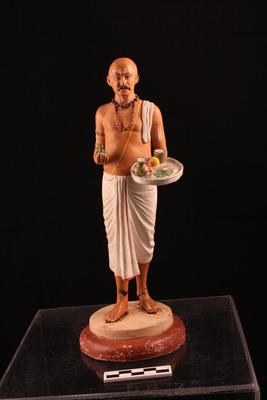E1285: India- Clay Figurine, Brahmin Priest
Ethnographic
Identifier:
E1285Classification Category:
8:Communication Artifacts ➞ Art/Folk ArtMarks/Labels:
On the bottom of the base is the mark AW185 with a diagonal red line through it. Also on the base is Ind185 that is faintly visible through white paint.Materials:
colorant ➔ paintclay
binding agents ➔ joiners ➔ metal wire ➔ armature
Dimensions:
9.4 cm L9.4 cm W
25 cm H
Provenance of Object:
The object was donated to the Boston Children's Museum by the Estate of William Whittemore in 1928. The Boston Children's Museum then gifted the object to the Luther College Ethnographic Collection in 2016.Families hire priests fo perform a daily ritual. He goes house to house. Each priest has special clients and his role is handed down father to son. The tray would hold kumkum powder, milk, betel nut leaf, turmeric, and fruit. Half would be given to the god and half would be kept on the tray.
Brahmins are one of the highest castes in Inia. At age 7, boys are initiated into the Brahmin caste and given a yellow, sacred thread. This indicates that they are of a superior caste. Wears a red dot to show that he is of a priestly caste.
Ethnic Group:
Asian ➞ IndiaProduction Date:
Prior to 1928Use/Function:
Families hire priests to perform a daily ritual. He goes house to house. Each priest has special clients and his role is handed down father to son. The tray would hold kumkum powder, milk, betel nut leaf, turmeric, and fruit. Half would be given to the god and half would be kept on the tray.Brahmins are one of the highest castes in India. At age 7, boys are initiated into the Brahmin caste and given a yellow, sacred thread. This indicates that they are of a superior caste. Wears a red dot to show that he is of a priestly caste.

